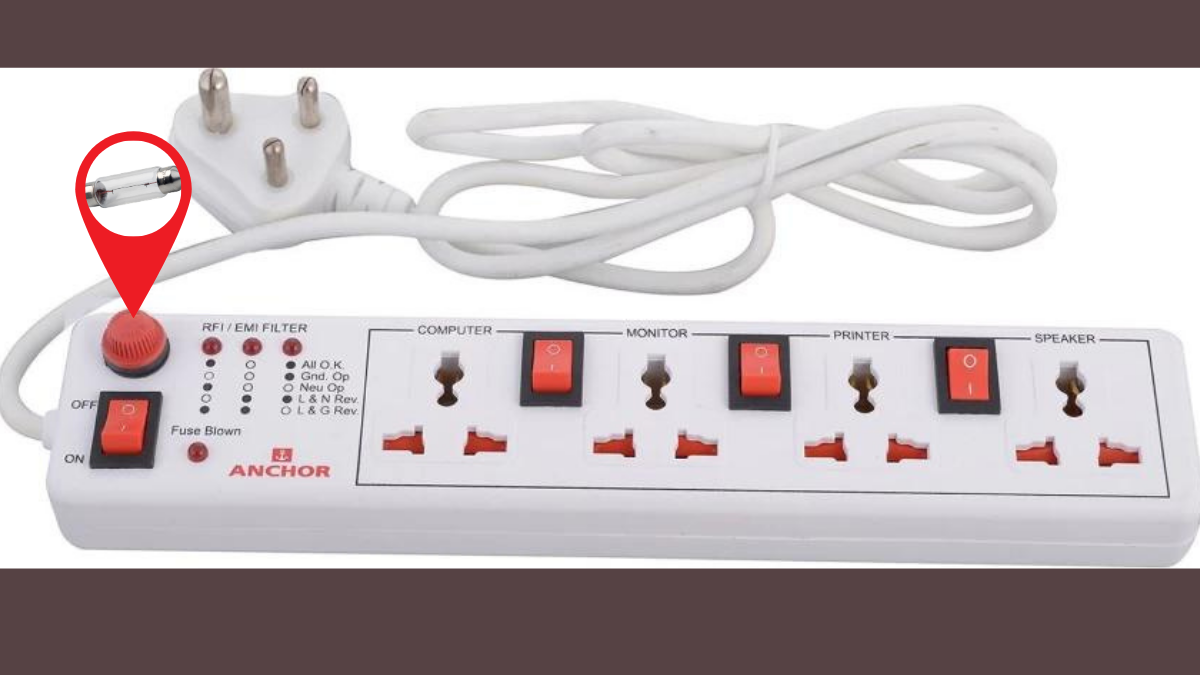Fuse kya hai aur extension board mein iska kya kaam hai, aaiye isko samjhte hain.

Fuse ek protective device hai jo short circuits aur overcurrent situations mein electrical devices ko protect karta hai. Fuse ek patli wire se bana hota hai, jo tin aur lead ke alloy se bani hoti hai. Inka melting point kam hota hai, aur ye wire do end se judi hoti hai. Jab fuse mein se zyada current flow hota hai, toh ye wire garam hokar melt ho jati hai aur toot jati hai, jisse ek gap create hota hai aur current ka flow ruk jata hai.
Extension board aur electrical circuits ko overcurrent aur short circuit se bachana iska ka main kaam hai. Jab current allowed limit se zyada hota hai, toh fuse melt ho kar circuit ko open kar deta hai, jisse current ka flow ruk jata hai aur electrical devices aur wiring ko protection milti hai.

Extension boards mein 5 Amp tak ke fuse commonly use hote hain. Extension board ek hi socket se multiple sockets ka access provide karta hai. Agar extension board mein high power devices ko ek sath plug-in kiya jaye, toh current ka flow badh sakta hai aur aag lagne ka khatra hota hai.
Agar extension board mein fuse na ho toh, excessive current se electrical devices damage ho sakte hain. Zada current hone se extension mein aag bhi lag sakti hai. Uske ke baad varistor bhi lagaya jata hai. Is varistor ko MOV (Metal Oxide Varistor) bhi kehte hain, jo voltage spikes hone par fuse ke liye short circuit create kr deta hai. Isse fuse over voltage ke time par bhi melt ho kar circuit ko open kr deta hai aur connected electrical devices ko over voltage aur voltage spikes se protection provide karta hai.
Toh make sure ki apke extension mein ek safety device ho. Jisse extension board aur devices protected rahe.
History
Fuses ka Janm
Hamari kahani late 19th century se shuru hoti hai, jab bijli ek mystery thi jaise chaand ke andhere side. Phir aaye fuses jo electrical safety ke unsung heroes hain. Ye electrical world ke Gandalf ki tarah hain, jo electrical overload ke samne keh dete hain, “You shall not pass!”

1890 mein, ek chatur insaan Thomas Edison ne pehla fuse patent kiya, jo ek simple lekin effective device thi. Ye ek wire hoti thi jise low melting point solder se do terminals ke beech solder kiya gaya tha. Jab current safety limits se zyada ho jata tha, wire melt hoti thi, aur ek open circuit create hota tha, is tarah se safety ensure hoti thi.
Safety devices ke Types
Voltage supply ke according fuses do main types mein classified hain
- DC Fuses (Direct Current Fuses)
DC fuses Direct Current electrical systems ke liye design kiye gaye hote hain. Ye overcurrent situations se protection provide karte hain. DC fuses ko DC current ke unique characteristics handle karne ke liye design kiya jata hai. Ye typically fusible element se bane hote hain jo excessive current flow ke samne melt ya vaporize ho jate hain.
DC fuses automotive, marine, solar power, battery charging, aur industrial applications mein commonly use hote hain. Inka size bhi generally bada hota hai aur inmein current ke ‘0’ volts ke aas-paas bhi continuity hoti hai, jo circuit ko deactivate aur remove karne mein thoda challenging hota hai. Electric arc ka potential bhi hota hai jab melting wires ke beech arc form hota hai, isliye electrodes ko thoda door-door rakha jata hai.
- AC Fuses (Alternating Current Fuses)
AC fuse Alternating Current systems mein important components hote hain. Ye circuit ko overcurrent conditions se protect karte hain. DC fuses ke comparison mein, AC fuses alternating current ko interrupt karne ke liye design kiye jate hain, jo periodically change hota hai.
AC safety devices generally chhote hote hain aur 50 se 60 times per second oscillate karte hain, low se high current tak. Isliye, electric arc formation ka risk kam ho jata hai aur inhe chhote sizes mein pack kiya ja sakta hai.
Toh fuses electrical systems ke liye essential safety components hain jo current overload se protect karke electrical equipment aur wiring ko safe rakhte hain.
Also read:

